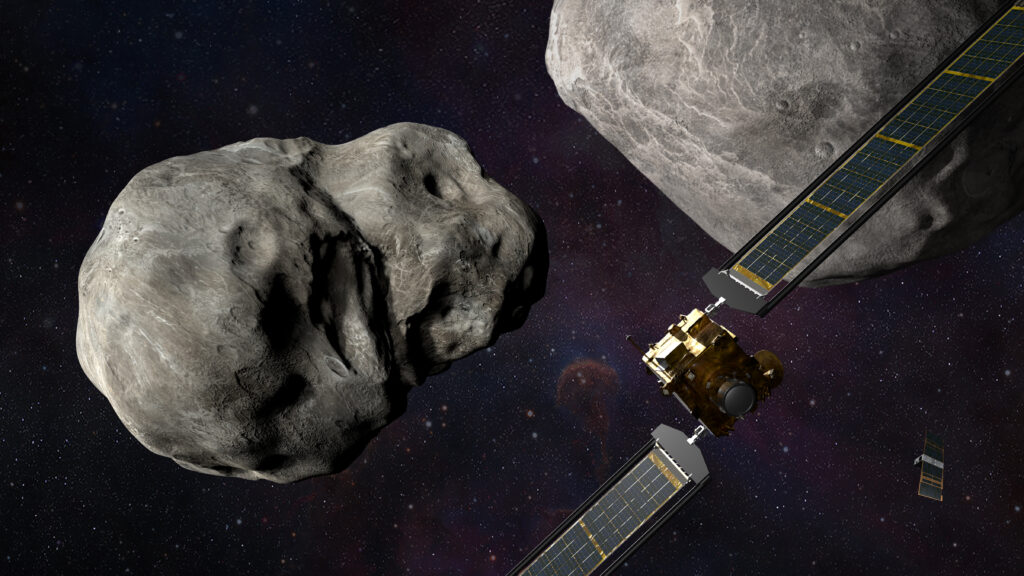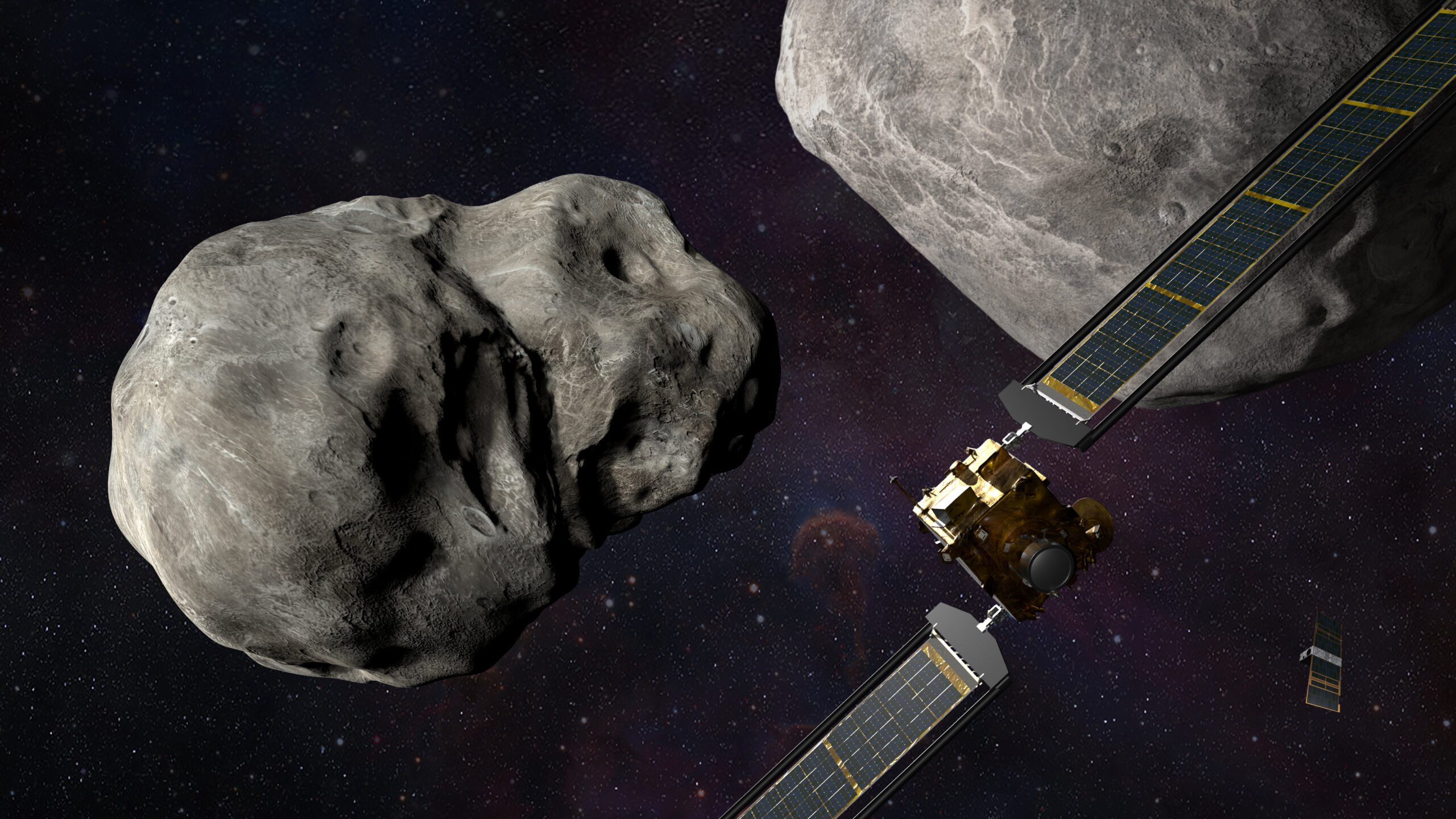Planetary defense just got real and that should mean new work for the Space Force. As the mission transitions from a theoretical necessity to a practical reality, the time has come to talk about the new service’s role in the mission. Presently no legislation or funding explicitly assigns responsibility for redirection of impact threats. Since the ability to redirect objects in orbit can be offensive as well as defensive, it is clear the Space Force should be involved. The mission may be more urgent than many realize. While the probability of a natural disaster remains long, the odds of an artificial hazard grow every day.
NASA has been tracking asteroids and comets that might pose a risk to Earth for years, but nobody had even demonstrated an ability to do anything about them until last week. On 26 September, 2022, NASA’s Dual Asteroid Redirect Test (DART) mission achieved a major milestone in planetary defense by deliberately changing the course of a celestial object. Data from this test will pave the way for much more specific conversations about planetary defense than were possible before. This includes what capabilities should be built to influence our celestial neighbors and who should operate them.
Planetary Defense
Though it is rarely in the public eye other than as cinematic hyperbole, planetary defense is serious business. Planetary defense is the collection of activities necessary to prevent an object from impacting Earth to devastating effect. Far from fiction, there is abundant physical evidence that such impacts happen frequently. While impacts severe enough to cause mass extinctions may occur only every few million years, those that could destroy cities occur about once per century (source: Defend Earth primer). Indeed multiple objects that might have caused record-setting natural disasters have struck Earth in the 20th and 21st centuries. Only chance averted disaster as they arrived over sparsely populated areas.
For more on planetary defense from The Planetary Society, visit their Planetary Defense Outreach Toolkit.
It is now possible to influence those odds. As with every other form of natural disaster, technology eventually offers an affordable mitigation. We learned to conduct controlled burns to prevent forest fires, built levies against floods, and used satellite early warning to evacuate populations out of the path of hurricanes. It is once again time we wrestle some measure of control away from fate by implementing a permanent system for effecting Earth impactors.
Planetary defense broadly consists of finding, characterizing, planning, and affecting impact threats. NASA’s Planetary Defense Coordination Office (PDCO), in cooperation with other agencies, international partners, and even private citizens, has been working on the first three steps for years. No agency, however, has been directed or resourced to operate and maintain an ability to act on a threat assessment.
The current inability to affect a threatening object isn’t for lack of ideas. While “nuclear options” like those seen in movies have been generally dismissed, many valid approaches have been put forward, including directed energy, gravity tractors, and kinetic impactors. One of the easiest to implement is the kinetic impactor, the technique demonstrated by DART.
DART
Kinetic impactors are slung directly into the target with sufficient mass and speed to bump it into a new orbit that is no longer a threat. NASA’s 570 kilogram DART traveled 10 months to precisely ram into its target, 160 meter wide Dimorphos, in a collision that is estimated to adjust its orbit by about 1%. Though just a test, the success proves that a kinetic impact approach to threat deflection is practical and, if conducted early enough, even a 1% change can be sufficient to avoid catastrophe.

Beyond proving the concept, DART lessons will inform improvements in planetary defense sensor, automation, and spacecraft technology as well as refine models to generate exactly the right collision to achieve the intended change in the target’s orbit. An operational system will apply this early work to be faster, more agile, and more effective.
Planetary Defense is a Military Mission
DART was planned before the Space Force existed, but the future of planetary defense must more directly include the Department of Defense. This argument has been made before, but so far contributions have been limited to planning and surveillance. It is vital that the job of actually deflecting objects rest with the Space Force.
Inherent Dual-Use
Any technology for deflecting asteroids is inherently dual use – meaning that despite peaceful intentions, it can inherently be used as a weapon. That most obviously means that some systems may be deflectors when pointed outward, but first strike weapons if pointed inward. Even if the capability itself were incapable of inflicting harm, the ability to steer an object away from a collision course with Earth comes hand in hand with ability to steer it toward an impact, making the celestial object itself the weapon and the deflection technology simply the trigger. Planetary defense capabilities are inherently dual-use as weapons and must be handled with great care. The military is already trusted thanks to relevant control frameworks including oversight, laws of armed conflict, international arms control enforcement, and coalition decision making.
Natural Disasters and Man-Made Hazards
Planetary defense has previously been described as defense against exclusively natural hazards, but that definition is rapidly becoming insufficient. As vividly depicted in some science fiction, impact threats may also be posed by deliberate redirection of natural objects, as described above, or even spacecraft themselves. As the number of objects placed in space rapidly grows and the number of nations and businesses operating in orbit rises, so too does the probability of malicious, negligent, or truly accidental impacts.
The ability to forcibly redirect a hijacked spacecraft or an off-course mining asteroid may soon become a more absolute and urgent requirement than defraying the odds of an asteroid or comet impact. Every capability that could serve one purpose could serve the other.
While many agencies are entrusted with combating natural disasters, only the Department of Defense is empowered and regulated to apply just force against foreign property, when so directed. Additionally, if the threat is posed by a man-made system, additional countermeasures could be brought to bear, including jamming and cyber effects already available to the military services.
The Right Capabilities and Competencies
In light of that expanded target set, other unique military competencies and capabilities become available to complement an effective planetary defense. While NASA and its partners resolve the detection of natural threats, it is the Space Force’s Space Surveillance Network (SSN), operated by the 18th Space Defense Squadron, that actively detects and tracks maneuvering objects. Though, DART effectively closed with an inanimate object, Delta 9’s orbital warfare officers train to close with objects that may evade intercept.
Reframe the Problem to Get the Policy Right
The United States must embrace a broader definition of planetary defense that includes man-made as well as natural disaster vectors. The logical result is to assign responsibility for the redirection portion of the planetary defense mission to the United States Space Force. The impact clock is ticking, but for the first time in human history, we could both predict when it will chime and influence the outcome… if we chose to.
Apathy and inaction are now the only possible culprits of cataclysm.











